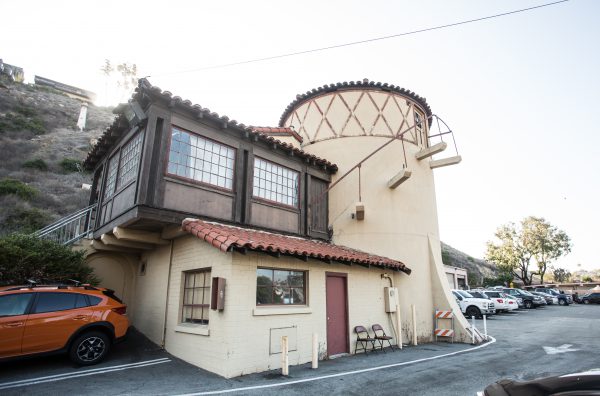
Laguna Beach awarded a contract in May to Walker Consultants to assess the physical and financial feasibility of constructing a new parking structure at the Village Entrance. The results—along with the recommendation that a 384-space, four-story structure costing about $16.6 million is the most financially feasible option—will be reviewed Tuesday by the City Council.
The study analyzed several factors for three options; a two, three and four-level structure on the site already owned by the City and accessible from Laguna Canyon Road and Forest Avenue. The report also assumes residents with a Shopper’s Permit will not be required to pay for parking in the structure, city employees will use the structure for weekday parking, and that the City will continue to enter into an agreement with Pageant of the Masters to provide 65 parking spaces for staff and cast members during the summer months.
According to the financial analysis, the design and entitlement cost is estimated at $2.75 million, of which $1.15 million is for preliminary design, environmental and geotechnical analysis and studies, with the remainder of the cost financed over a 30-year period. The $1.15 million will come from the Parking Fund, which has a projected balance of $3.38 million for Fiscal Year 2020-21. City staffers recommend that councilmembers proceed with the design and entitlement of their chosen option, which will prepare the project for Design Review and a proposed coastal development permit by the Planning Commission and the City Council in early 2022.
“This has been needed for a long time,” said Paula Hornbuckle-Arnold, President and CEO of the Laguna Beach Chamber of Commerce. “Laguna Beach is notoriously known for not having enough parking. Anyone who can see past their own opinion sees it’s necessary. I know some people feel that by building a parking structure more people will come, but they will come anyway.”
Hornbuckle-Arnold notes that popular days see drivers circle the downtown looking for spaces and create congestion.
“I would vote for option three since it makes the most sense financially, but if it requires a height variance and if that delays it, I would be in favor of option two,” she said.
Johanna Felder, president of Village Laguna, disagrees, claiming the study “is seriously flawed and biased to build a parking structure that Laguna taxpayers can’t afford and don’t need. Looking past the assumption about how little the parking lot would cost—the real cost will be much more—and many other dubious assumptions, the numbers they present don’t hold true.”
Felder said that not only does the report recommend option three, which violates the height limit with a 48-foot-tall structure, but claims revenue based on the total spaces of the proposed structure, not the 258 new spaces created.
“In other words, the report claims revenue for parking spaces that already exist [in the current lot],” she said. “Take away this revenue and their business case collapses like a house of cards.”
According to the study, while none of the three options are expected to generate positive net income in their first full year of operation, over a 10-year period, it is projected the structure will create revenue that exceeds projected expenditures, including debt repayment. Option 3, which provides the most spaces, would result in an estimated cost of $64,000 per space gained.
“This option provides the most long-term public benefit by creating over 250 new parking spaces for the downtown area, which can also compensate for the reduction of parking spaces on Forest Avenue if the Promenade on Forest becomes permanent, at the lowest estimated cost per space,” the study said.
Felder said the numbers don’t make sense. “In year one, they say net income will be a loss of ($37,000). This is wrong,” she said. “The real loss is ($419,300). Using their historical value of $2,250 revenue per parking space x 258 net spaces = $580,500 of year one revenue; not the $963,800 value in the report, which they don’t adequately explain. They also base their revenue analysis on the total financed cost that excludes the design and entitlement costs of $2,750,000. Adding these costs brings the tally to almost $20 million.”
Roger Butow, a local land use consultant who has watchdogged the Village Entrance for years, said the city shouldn’t build a structure taller than two stories because downtown sits in a floodplain with loose, sandy soil beneath it.
“I spent several years analyzing and critiquing the site,” Butow said. “There are several earthquake faults in our vicinity, even a moderate one would exhibit ‘liquefaction,’ with rolling motions that degrade rigid structures… Stabilizing such a monolithic structure would require dozens of deeply drilled and embedded caissons.”
The groundwater and soil beneath the Village Entrance site is highly contaminated, Butow said, adding that federal environmental law would require whoever breaks ground to remediate the soil and water. The costs associated with bioremediation are relatively unknowable until after excavation begins, he said.
Butow suggests that a dual-level structure at the ACT V lot would be a less expensive and safer option with trolleys bringing people into town.
Councilmember Toni Iseman also recommended that the city consider studying additional potential structure sites—with an additional $12,000 added for each location to the original $35,000 contract. A majority of the City Council decided not to expand the study.
Felder believes only developers would benefit from the parking structure and that parking costs would rest on already over-burdened taxpayers.
“It seems that this report paves the way for Laguna taxpayers to get hosed once again by a City Council that spends money it doesn’t have for projects no one wants,” Feldman said.
“People make up their own narrative,” Hornbuckle-Arnold said. “I don’t see anywhere in the study where this says it’s going to rest on the backs of residents.”





Here we go again. A biased and flawed study that we the taxpayers who are voiceless in the current developer dominated council will have rammed down our throats. Liberate Laguna has endorsed the two candidates that will ensure a council/developer symbiosis even more egregious than even what we now have. The fact that the ground is subject to liquefaction is no problem because,
after all, the suckers, I mean property owners, will pick up the tab in case of a ctastrophic failure due to an earthquake.
Here we go again, same treadmill, more consultants, same old sitz. This town’s planning visionaries are incapable of comprehending mobility planning. https://lagunastreets.blogspot.com/2013/10/toc.html
So this ground liquefaction problem you’ve identified – is it just the area beneath the proposed parking structure, or does it extend further?
I’m fairly certain that a geotechnical report will be required prior to any construction so if that’s the case, we’ll soon know all about it. You could of course try to submit the report you’ve accessed, or perhaps you’re a soils engineer and have studied this area in depth?
My hunch, nothing much to back it up other than 4 years of Civil Engineering, but today’s structures in California are designed to withstand earthquakes of a substantial magnitude. If as you foresee, the big one requiring the taxpayers to pay up, we’ll be paying for a lot more than a relatively simple reinforced concrete parking structure. I also expect it will be insured – our city council is prudent.
However you’re entitled to promote bogeymen; we just don’t have to believe in them.
Laguna Beach is short of affordable housing. Should we build housing structures for people or cars?